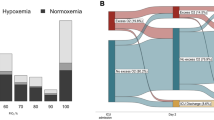Abstract
Purpose
Network analysis was conducted to systematically analyze the relationship between causative drugs and types of drug-related problems (DRPs) in hospitalized patients with hematologic malignancies.
Methods
A total of 1187 DRPs identified in hematology wards between 2013 and 2015 were analyzed. DRPs were classified into 11 sub-domains for problems and 35 sub-domains for causes according to Pharmaceutical Care Network Europe classification. Causative drugs were classified by Anatomical Therapeutic Chemical code. Network analytic tool was used to represent the relationship between drugs, causes, and problems. In-degree centrality (CD-in) was calculated to identify major causes of DRPs.
Results
The following drugs accounted for more than 5% of DRP, including antibacterials (J01, 26.5%), drugs for acid-related disorders (A02, 11.5%), antiemetics (A04, 9.7%), antifungals (J02, 8.8%), and antineoplastic agents (L01, 7.0%). Inappropriate combinations (C1.3, CD-in of 161) of drugs for acid-related disorders, antifungals, and antineoplastic agents were major causes of DRPs and induced non-optimal effects of drug treatment (P1.2). Inappropriate dose adjustments (C3.6, CD-in of 151) of antibacterials lowered effects (P1.2) and increased side effects (P2.1). Missing necessary synergistic or preventive drugs, especially antiemetics, (C1.8, CD-in of 54) resulted in untreated indication (P1.4).
Conclusions
DRPs were mainly related to medications for supportive care. More attention should be paid to interactions of drugs used for acid-related disorders, dose adjustment of antibacterials, and omission of antiemetics in hospitalized patients with hematologic malignancy.
Similar content being viewed by others
References
Koh Y, Kutty FB, Li SC (2005) Drug-related problems in hospitalized patients on polypharmacy: the influence of age and gender. Ther Clin Risk Manag 1:39–48
Pharmaceutical Care Network Europe Foundation (2010) Classification for drug related problems V6.2. http://www.pcne.org/upload/files/11_PCNE_classification_V6-2.pdf. Accessed 8 February 2017
Ko Y, Gwee YS, Huang YC, Chiang J, Chan A (2014) Costs and length of stay of drug-related hospital admissions in cancer patients. Clin Ther 36:588–592. https://doi.org/10.1016/j.clinthera.2014.02.014
Chan A, Soh D, Ko Y, Huang YC, Chiang J (2014) Characteristics of unplanned hospital admissions due to drug-related problems in cancer patients. Support Care Cancer 22:1875–1881. https://doi.org/10.1007/s00520-014-2160-0
Edwards SJ, Abbott R, Edwards J, LeBlanc M, Dranitsaris G, Donnan J, Laing K, Whelan MA, MacKinnon NJ (2014) Outcomes assessment of a pharmacist-directed seamless care program in an ambulatory oncology clinic. J Pharm Pract 27:46–52. https://doi.org/10.1177/0897190013504954
Ribed A, Romero-Jimenez RM, Escudero-Vilaplana V, Iglesias-Peinado I, Herranz-Alonso A, Codina C, Sanjurjo-Saez M (2016) Pharmaceutical care program for onco-hematologic outpatients: safety, efficiency and patient satisfaction. Int J Clin Pharm 38:280–288. https://doi.org/10.1007/s11096-015-0235-8
Yeoh TT, Tay XY, Si P, Chew L (2015) Drug-related problems in elderly patients with cancer receiving outpatient chemotherapy. J Geriatr Oncol 6:280–287. https://doi.org/10.1016/j.jgo.2015.05.001
Bremberg ER, Hising C, Nylen U, Ehrsson H, Eksborg S (2006) An evaluation of pharmacist contribution to an oncology ward in a Swedish hospital. J Oncol Pharm Pract 12:75–81. https://doi.org/10.1177/1078155206070412
Bulsink A, Imholz AL, Brouwers JR, Jansman FG (2013) Characteristics of potential drug-related problems among oncology patients. Int J Clin Pharm 35:401–407. https://doi.org/10.1007/s11096-012-9747-7
Yeoh TT, Si P, Chew L (2013) The impact of medication therapy management in older oncology patients. Support Care Cancer 21:1287–1293. https://doi.org/10.1007/s00520-012-1661-y
Puts MT, Monette J, Girre V, Costa-Lima B, Wolfson C, Batist G, Bergman H (2010) Potential medication problems in older newly diagnosed cancer patients in Canada during cancer treatment: a prospective pilot cohort study. Drugs Aging 27:559–572. https://doi.org/10.2165/11537310-000000000-00000
Delpeuch A, Leveque D, Gourieux B, Herbrecht R (2015) Impact of clinical pharmacy services in a hematology/oncology inpatient setting. Anticancer Res 35:457–460
Cavero Rodrigo E, Climente Martí M, Navarro Fontestad MC, Jiménez Torres NV (2007) Quality assessment of two pharmaceutical care models for onco-haematological patients. Farm Hosp 31:231–237
Farias TF, Aguiar KD, Rotta I, Belletti KM, Carlotto J (2016) Implementing a clinical pharmacy service in hematology. Einstein (Sao Paulo) 14:384–390. https://doi.org/10.1590/S1679-45082016AO3667
Chew C, Chiang J, Yeoh TT (2015) Impact of outpatient interventions made at an ambulatory cancer centre oncology pharmacy in Singapore. J Oncol Pharm Pract 21:93–101. https://doi.org/10.1177/1078155213519836
Lopez-Martin C, Garrido Siles M, Alcaide-Garcia J, Faus Felipe V (2014) Role of clinical pharmacists to prevent drug interactions in cancer outpatients: a single-centre experience. Int J Clin Pharm 36:1251–1259. https://doi.org/10.1007/s11096-014-0029-4
WHO Collaborating Centre for Drug Statistics Methodology (2017). ATC/DDD Index 2017. https://www.whocc.no/atc_ddd_index/updates_included_in_the_atc_ddd_index/new_atc_codes_2017/. Accessed 8 February 2017
Overhage JM, Lukes A (1999) Practical, reliable, comprehensive method for characterizing pharmacists' clinical activities. Am J Health Syst Pharm 56:2444–2450
Opsahl T, Agneessens F, Skvoretz J (2010) Node centrality in weighted networks: generalizing degree and shortest paths. Soc Networks 32:245–251
Merck Sharp & Dohme Corp. (2016) Noxafil (posaconazole): Highlights of prescribing information. https://www.merck.com/product/usa/pi_circulars/n/noxafil/noxafil_pi.pdf. Accessed 20 Feb 2018
Bristol-Myers Squibb (2010) Sprycel (dasatinib): Highlights of prescribing information. https://www.accessdata.fda.gov/drugsatfda_docs/label/2010/021986s7s8lbl.pdf. Accessed 20 Feb 2018
Novartis Pharmaceuticals Corporation (2017) Tasigna (nilotinib): Highlights of prescribing information. https://www.pharma.us.novartis.com/sites/www.pharma.us.novartis.com/files/tasigna.pdf?printmode=true. Accessed 20 Feb 2018
Kim DS, Park CS, Jang SM (2008) The impacts of guideline for digestives on physicians’ prescription of GI medication. Korean J Clin Pharm 18:124–131
Darmon M, Ciroldi M, Thiery G, Schlemmer B, Azoulay E (2006) Clinical review: specific aspects of acute renal failure in cancer patients. Crit Care 10:211
Acknowledgements
This work was supported by The Health Fellowship Foundation and the 2017 Brain Korea (BK) 21 Plus.
Financial disclosure
The Health Fellowship Foundation, National Research Foundation of Korea (BK Plus 2017).
Author information
Authors and Affiliations
Corresponding author
Ethics declarations
Conflict of interest
The authors declare that they have no conflict of interest.
Electronic supplementary material
ESM 1
(DOCX 164 kb)
Rights and permissions
About this article
Cite this article
Kim, M.G., Jeong, C.R., Kim, H.J. et al. Network analysis of drug-related problems in hospitalized patients with hematologic malignancies. Support Care Cancer 26, 2737–2742 (2018). https://doi.org/10.1007/s00520-018-4106-4
Received:
Accepted:
Published:
Issue Date:
DOI: https://doi.org/10.1007/s00520-018-4106-4




